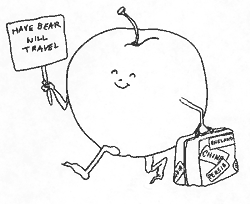STRANGE BUT TRUE- Pip, pip! How apple trees travel the world
Published April 12, 2007 in issue 0615 of the HooK.
By BILL SONES AND RICH SONES, PH.D. [email protected]

DRAWING BY DEBORAH DERR McCLINTOCK
Q. From Belle de Boskoop to Cox's Orange Pippin and 20,000 others, they're loaded with vitamins and antioxidants and can be cooked, dried, fermented or eaten without any preparation whatsoever. They've come down to us through the millennia courtesy of transporting birds, bears of the forests, and even horses and donkeys. Easy as pie, right? --J. Chapman
A. Ancestral "neo-apples" (the size of a grape) go back 60-70 million years, then by 10-12 million years ago a recognizable apple appeared in what is now central China. The pips, or seeds, were likely transported by birds and flourished in the fruit forests of the Tian Shan Mountains,
says Barrie Juniper in American Scientist. Then along came sweet-tooth bears, who unconsciously selected the larger specimens and were in effect an evolutionary force toward BIG. Since bears' jaws and guts do little damage to the hard-coated apple pips, germinating "loads" were spread all over the mountain range. Wild horses too played their part, ranging farther and more widely than the bear. Later, apple pips moved west in the guts of domesticated horses and donkeys, whose sharp hooves unwittingly planted the seeds at every oasis. Finally, from Europe the apple moved across the seven seas, rounding out the sweet apple (pie) saga.
Q. There's a thunderstorm approaching. Can you estimate how far off it is? --B. Franklin
A. The lightning's light streaks to your eyes at 186,000 miles per second (!), virtually instantaneous, with the thunder dawdling at just 1,100 feet per second, says University of Oklahoma geoscientist John T. Snow. So it takes the sound 5 seconds for every mile (3 seconds per kilometer) to reach you. Just count the seconds of delay, "1001, 1002, 1003...," divide by 5 (3) and know the storm's distance. Since the bolt is actually several short bursts strung together, multiple shock waves are created at different altitudes. These factors and the multiple echoes from the sound bouncing between the cloud and the ground are why thunder seems to rumble as it does.
Q. Oh, no, rats have invaded your dwelling! What might the varmints discover about your family that you don't know? --P.P.O. Hamelin
A. That the genetically related bunch of you all have rather similar body odors. When the University of Chicago's Erin Ables presented rats with novel smells, they investigated longer than for familiar smells. Moveover, they investigated longer when presented with the smells of novel non-relateds than with related family members, supporting the idea that body odors have a genetic basis. Previous research had also suggested that we humans, when pressed, can distinguish between odors of our relatives vs. non-relatives, a capacity that may help steer our species away from inbreeding.
Q. What's the secret to a basketball player's soaring hang time in going for the basket, making him seem to defy gravity? Three secrets really. --M. Jordan
A. #1. During the jump, gravity slows the player more and more toward the top so that he spends about 70 percent of the time in the upper half of the leap, says John J. Fontanella in The Physics of Basketball. #2. Spending longer near hoop level, he also travels farther horizontally there, seeming to float. #3. A powerful dunk shot, where he raises the ball on the way up and lowers it coming down, effectively levels off his body's overall trajectory. Of course, if he actually grabs the rim briefly for a little theatrics, the "illusion of hang time" becomes literal.
Q. We do it, apes do it, dolphins do it, and so too do elephants. Whatever we're all doing, what special object do we need to do it? --E. Queen
A. A mirror of suitable size, allowing us to recognize ourselves in the reflection and pass a self-awareness test failed by most of our primate relatives, says New Scientist magazine. Diana Reiss of Columbia University proved the case for dolphins before turning her attention to another large-brained empathetic species, the Asian elephant. When she presented three Bronx zoo elephants with a mirror, it was fascination at first sight. The pachyderms began inspecting themselves with their trunks while eyeing their reflections, with one repeatedly touching a mark painted on its head. But the mirrors had to be huge because elephants have poor eyesight, a fact which foiled earlier attempts at testing elephant self-recognition. It's not always easy to come up with elephantine mirrors.
Send Strange questions to brothers Bill and Rich a [email protected].
#
|
|


Discuss "STRANGE BUT TRUE- Pip, pip! How apple trees travel the world" Below